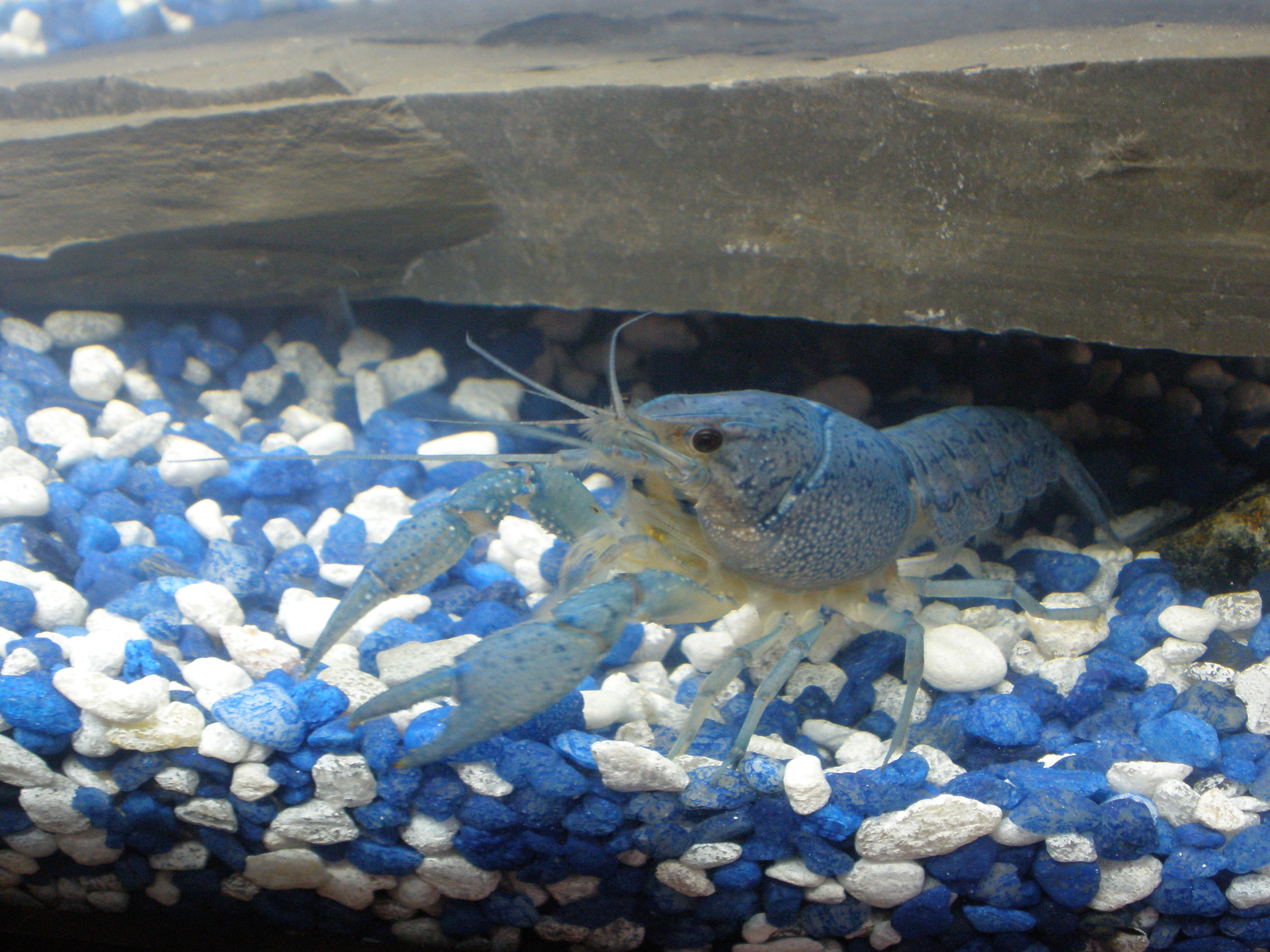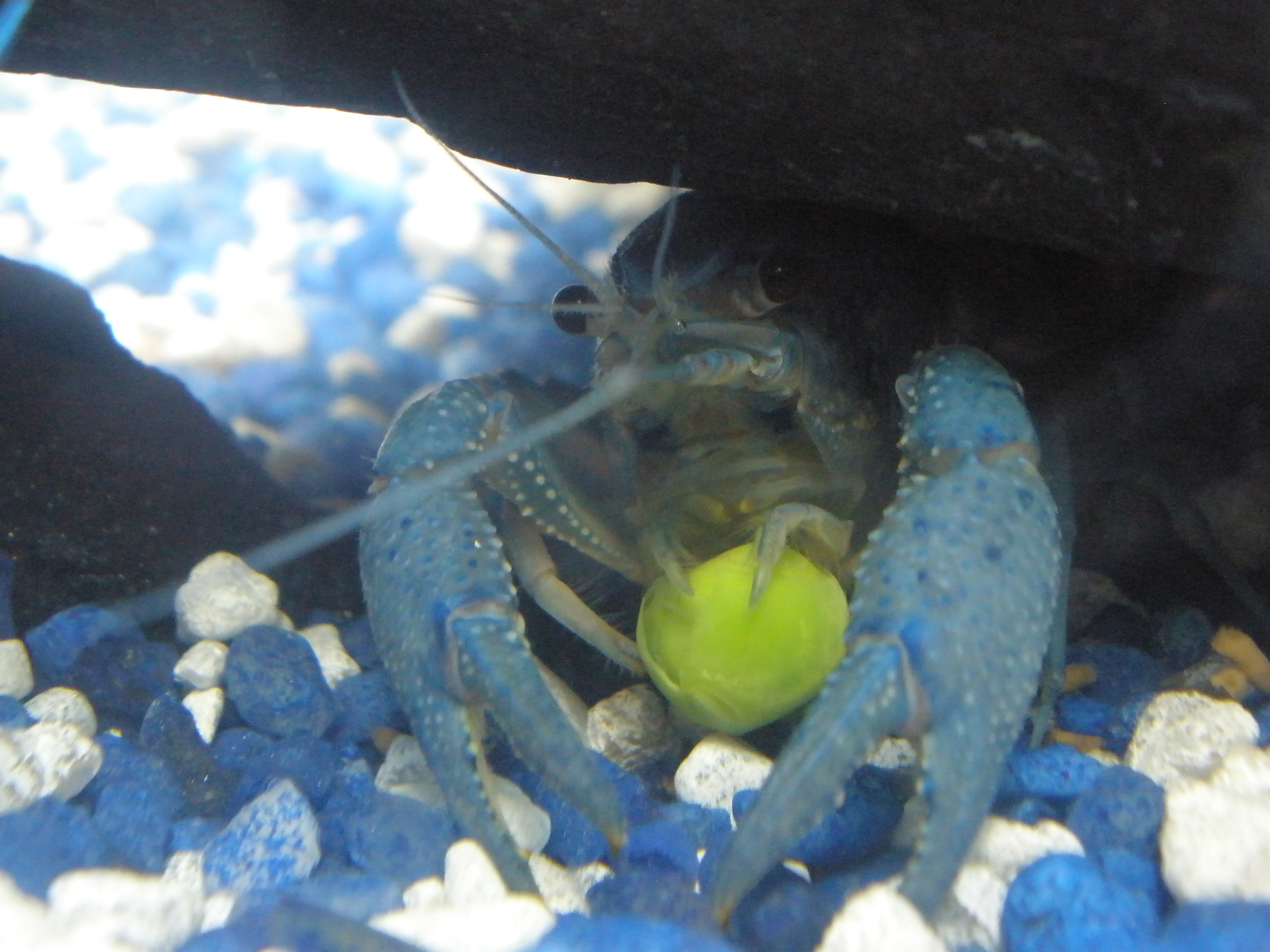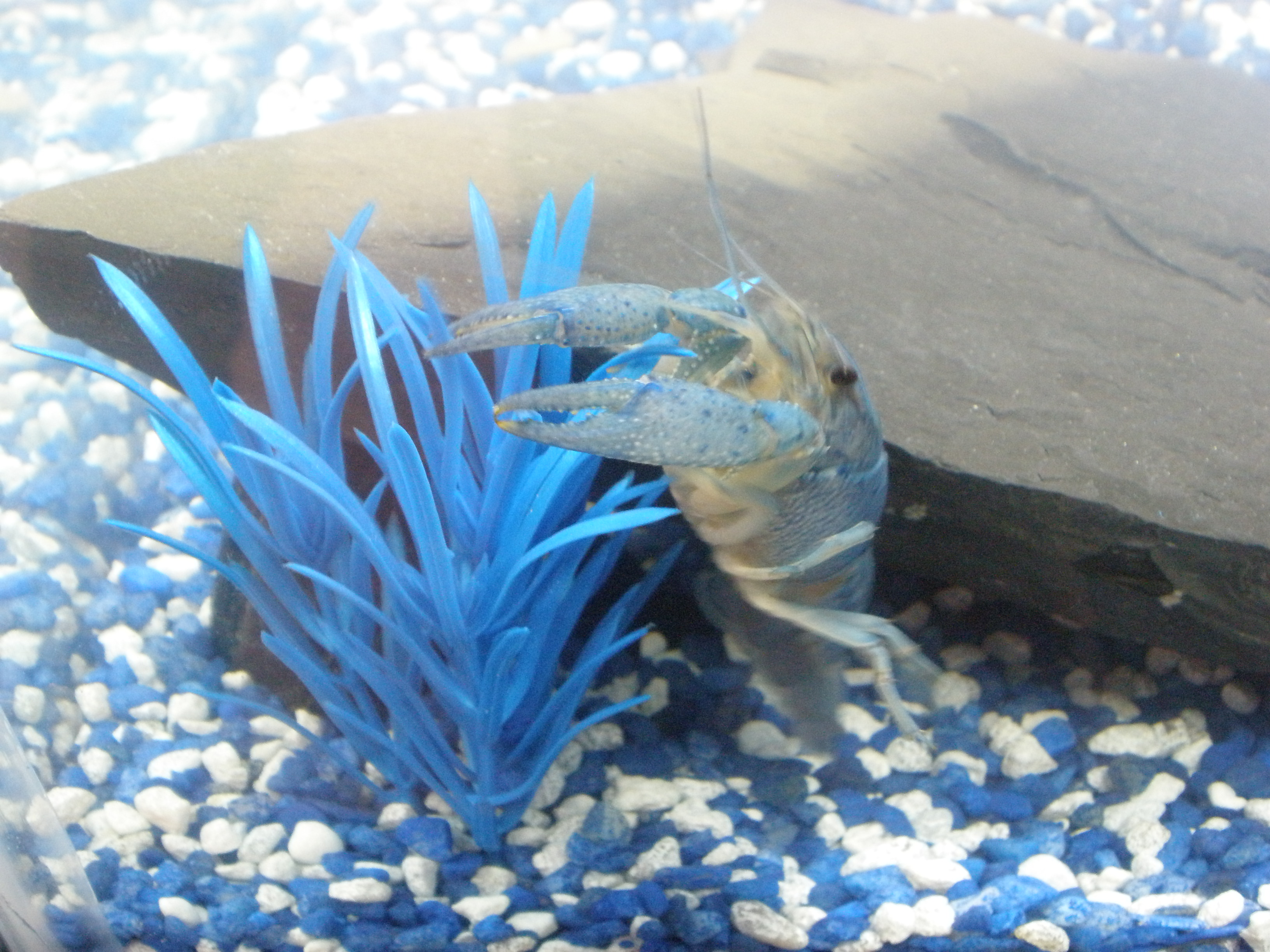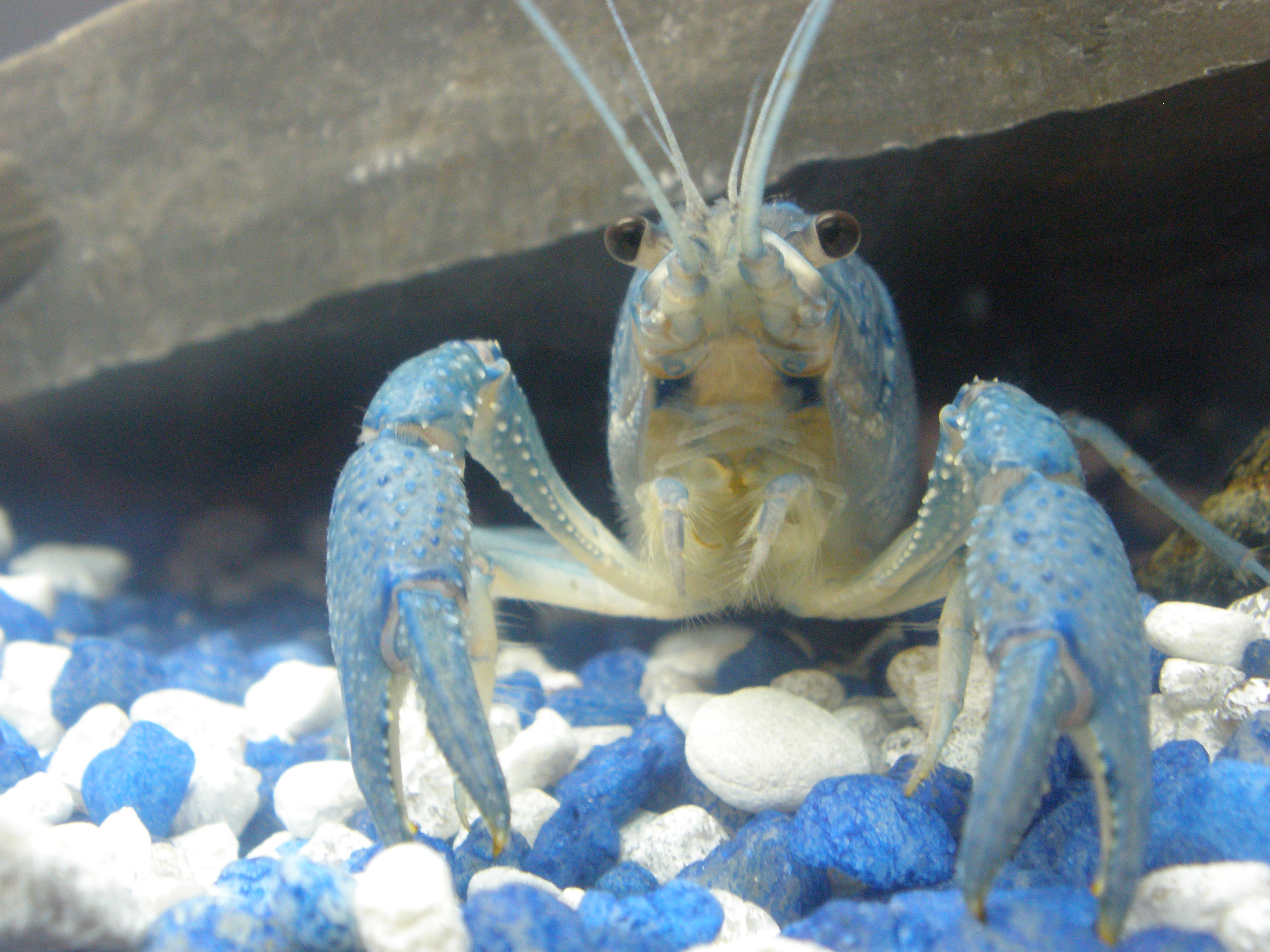After a lot of consideration, Ted and I have decided that the time is right for us to expand our little family of two to a family of three. So please welcome:
Maverick
Name: Blue Crayfish (freshwater) or Blue Lobster (saltwater)
Scientific Name: Procambarus alleni
But we call her: Maverick (Mav)
Life expectancy: 2 – 5 years
Max size: 8”
Eats: Anything she can get her pinchers on. Favorites include raw zucchini, frozen peas, lettuce, cooked cocktail shrimp, crab/lobster/catfish/shrimp pellets for bottom-dwellers, algae rounds (her true favorite!), bloodworms, krill, feeder fish, live aquatic plants, and slow tank-mates.
Habitat: Aquatic, but she can live out of water as long as her gills stay damp.
Coloration: Naturally blue, but to aide in retaining her bright hue we added gravel that is similar in color and vibrancy to her shell, and we were sure to give her a slate hiding cave where she feels safe and secure, as stress is rumored to reduce a cray’s vividness and possibly coloration.
Molting: Crays will molt their shell once every few months as they grow. Her old shell will remain in the tank for up to one week after for her to eat as an intake of calcium. Cray’s feel especially vulnerable when they are molting, therefore having a cave to hide in helps them feel a little less endangered.
Habits: Crays make a hobby of stalking and swiping at unsuspecting fish, climbing rocks, scaling the tank’s plants/filter tube/heater, digging and burrowing in the gravel, rearranging their tank decorations, moving gravel across the tank piece by piece, hording food, and swimming really freakin’ fast using their tail as a scoop to propel them forward or backward.
Tank-mates: Crays enjoy the fine art of catching and snacking on any tank-mates that are slower or dumber than their pinchers. But they will also be mercilessly plucked apart while molting by any tank-mates that are more aggressive than they are. Crays are also not very kind to one another. Many crays live alone for this reason. The best tank-mates are small, fast, top-dwelling, non-aggressive fish that the cray (try as they may!) cannot catch but who will not be aggressive toward the cray when they are molting – like marble hatchets.
Qualities: Luckily, crays are fairly adaptable creatures. Though, like any fish, they prefer certain pH levels and water temperatures over others, they are able to adapt well to different conditions so long as they are acclimated properly and the elements remain stable and do not fluctuate vastly or frequently. Stability takes priority over a perfect test kit reading any day.
Aquarium: 20 gallon freshwater – mix of about ½ tap water and ½ reverse osmosis (RO) water – with a lid because it’s totally necessary! Cray’s are major escape artists. “February 26th, day 173, plan Q…” Ted and I joke about Mav’s escape plots.
Filter: ChemiPure’s Carbon Ion filter and a regular polyfiber filter.
Additives: 2 mL of SeaChem Prime, 2 mL of a tap water dechlorinator, and the occasional dose of liquid calcium for invertebrates to keep her shell healthy.
Lighting: Fluorescent, about 6 hours a day, with the tank situated out of direct sunlight.
Tank Accessories: Filter, pump, submersible heater, digital thermometer, and wall bubbler.
Substrate: 25 lbs of blue and white gravel mixed, thoroughly rinsed with no soap.
Decorations: Gravel, 4 artificial plants, and a slate rock/cave.
Aeration: Pump with under-gravel wall bubbler to relieve water pressure and oxygenate the tank with bubbles.
Cleaning: We’re working our way through the first “ammonia to nitrite to nitrate” cycle, so after this first cycle is complete we’ll be doing a bi-weekly or monthly 10-20% water changes with RO water, gravel vacuuming, and scrubbing the inside of the tank with an algae pad. Filter gets changed once every six months.
Testing supplies: API Freshwater Master Liquid Test Kit to test for ammonia, nitrite, nitrates, and pH. Because our tap water is so freakishly alkaline, we have to use the API High-Range pH test kit for pH’s of 7.6-8.8 (which is actually saltwater tank territory, not freshwater….thanks, Ohio).
Temperature: Range of about 55-75° is ideal. Ours is set to stay around 71°.
pH: Typically a range between 7.0 and 7.6 is ideal. Crays prefer slightly cooler, harder, and more alkaline water. But because Cincinnati has insanely hard water with very a high pH value, our tank is sitting between a 7.8 and 8.0, even with the addition of ½ RO water – which generally has a neutral pH of 6.8-7.0 – to lower the tank’s pH. Researching all this crap for the past two weeks, attempting to remedy it naturally through much trial and error (which created an unfortunate bacterial bloom that forced us to completely flush the tank and sent us right back to square one), and then just accepting it because that’s really all we can do at this point without chemical interference – which can negatively effect stability and lead to pH spikes and crashes – has been a battle of epic proportions. I’ve learned more about RO water, pH, kH, gH levels, and the inner-workings of the nitrogen cycle than I ever wanted to know.
Acclimation: When first brought Mav home from the store we floated the plastic bag with her in it in the tank for about 1 hr so the water temperatures could assimilate. Then every 5 minutes for the next 30 minutes we added a small amount of tank water to the bag so she could adjust to the different water quality and chemical balances in our water versus her tank’s water at the store.
And I thought getting a fish was as easy as it was when I was a kid – buy tank, fill with faucet water, throw in some gravel, and insert fish. HA.
I love her eyes – they’re so big and awesome!
So what do you think of our new addition?





i lOVE her! she’s so cool!